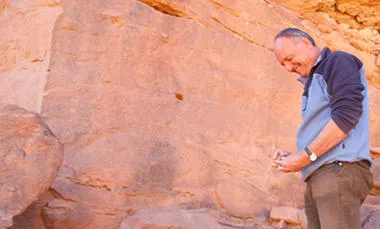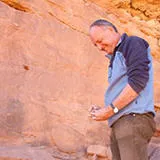13 April 2018
Fossil Finger Points to Earlier Human Migration
An international team, including Professor Nick Drake and Dr Paul Breeze, has discovered the first fossil evidence of early humans, Homo sapiens, on the Arabian peninsula.

An international team, including Professor Nick Drake and Dr Paul Breeze, has discovered the first fossil evidence of early humans, Homo sapiens, on the Arabian peninsula. The finding, a fossil finger bone from the site of an ancient lake in Saudi Arabia, challenges long-held assumptions that early humans did not live widely outside Africa until 60,000 years ago.
The bone, the middle of the three bones that make up a finger, was discovered in 2016 at the Al Wusta site, an ancient freshwater lake that existed surrounded by grasslands. Long-since dried up, the lake site is now part of the arid Nefud Desert in Saudi Arabia. Although evidence of ancient humans has been found across the Arabian peninsula, in the form of stone tools, no fossil skeletal evidence of early humans has ever been found, until the discovery of this single bone. Using CT scanning, the team created a three dimensional model of the finger bone, comparing this to finger bones from early early Hominid and Neanderthal remains from the same period. They concluded that the finger bone belonged to Homo sapiens.
The team dated the bone to approximately 85,000 years ago, making this the oldest directly-dated fossil of our species to ever be found outside of Africa and the Levant.
It has until now been theorised that Homo sapiens first dispersed out of Africa between 130,000-90,000 years ago but that this dispersal was restricted, encompassing only the Mediterranean forests of the Levant region. This was then followed by a later , extensive and successful dispersal between 60,000-50,000 years ago: genetic evidence suggests that all living non-Africans can trace their ancestry to this later dispersal.
However, this discovery adds to other mounting evidence from finds in Israel and Asia that suggests that there were in fact multiple dispersals out of Africa and that these may have been more expansive than previously thought.
Speaking to the BBC, the lead author of the study, Dr Huw Groucutt, suggested that a 'great mystery' was what happened to the people who dispersed across Saudia Arabia, as evidence from the research site suggests that occupation of the area may have been short-lived. It's not clear whether early dispersers moved on further or died out. The research team suggest however that there is much more to discover at sites across Saudi Arabia which could help to provide answers.


